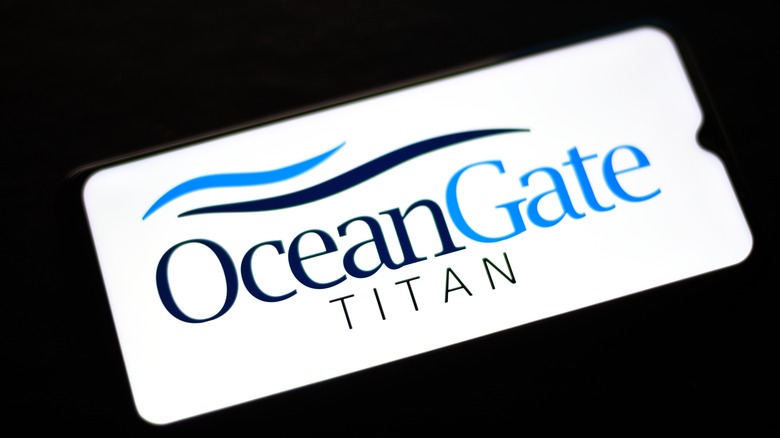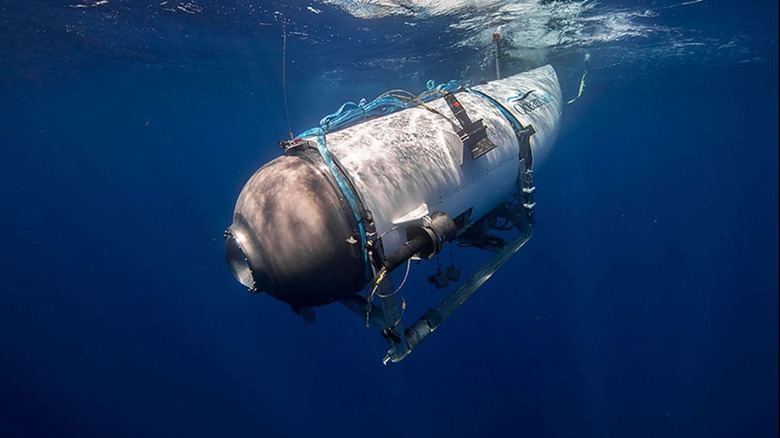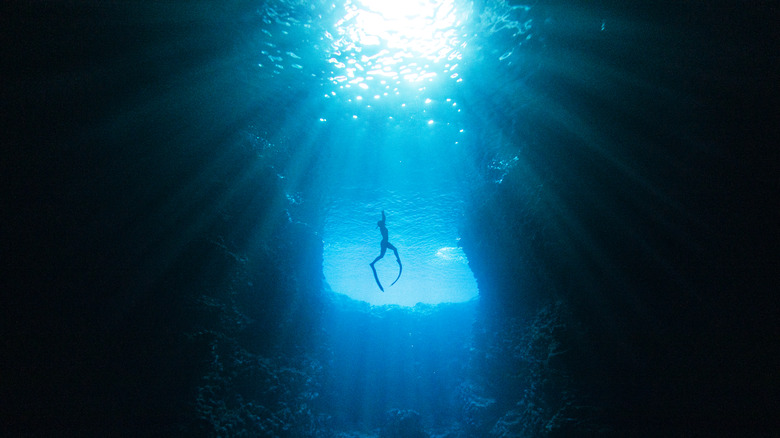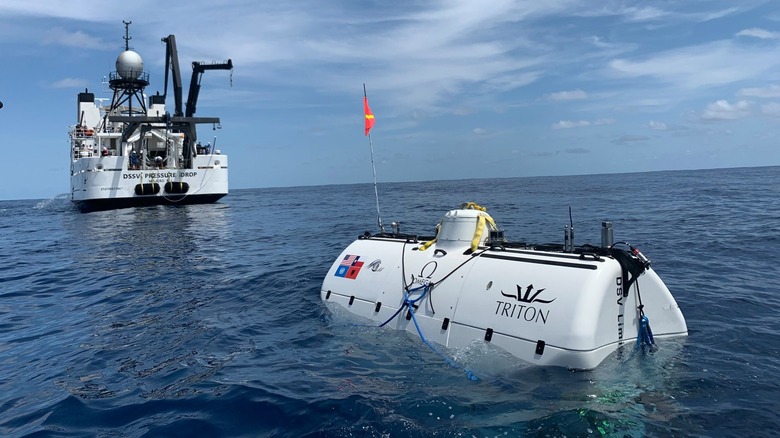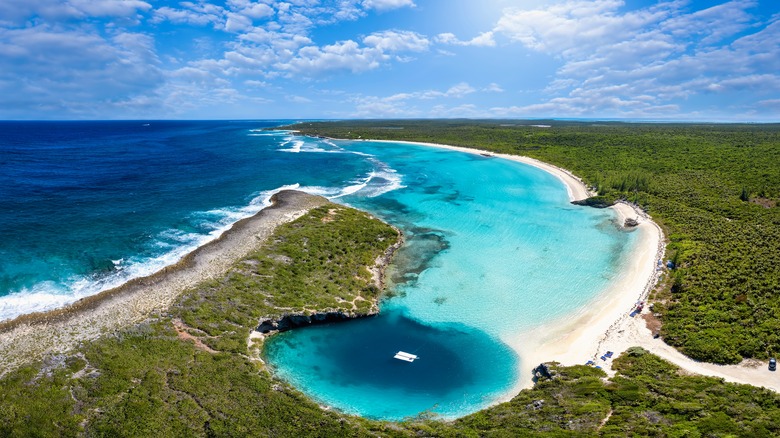Billionaire's Planned Titanic Trip Proves We've Learned Nothing From The Titan Sub
On June 18, 2023, five individuals lost their lives trying to do something fewer than 250 people have done: Visit the Titanic wreckage. It was a tragic incident that largely happened because safety was thrown to the wind. That hasn't stopped other deep-sea explorers from attempting the same endeavor. After all, filmmaker James Cameron has made the trek 33 times and even traveled as deep as the Mariana Trench, the deepest point on Earth at 35,756 feet. Triton Submarines isn't viewing OceanGate's failure as a sign to stop, but rather to persist.
Billionaire Larry Connor contacted Triton's CEO not long after the OceanGate incident and got started on plans to build a submersible that can safely make it to the Titanic in an attempt to prove to the world that there's nothing to worry about. As CNN reports, Connor called Triton only days after the incident, which many could interpret as a lack of concern or respect for those who perished in the Titan incident. Connor claims that he wants to prove to the world that traveling as deep as the Titanic in a well constructed submersible is safe, but is that really the lesson that needs to be taught?
There's a certain amount of respect people need to show the ocean, and nature in general. It doesn't care if you have a family or want to set a new world record. Nature will behave how it behaves. More importantly, not everybody can afford a safe trip down to the Titanic.
The OceanGate incident
In June 2023, Stockton Rush, cofounder and CEO of OceanGate, took the Titan submersible (not to be confused with a submarine) into the Atlantic Ocean. He, along with four other individuals, were on a mission to dive and see the wreckage of the ill-fated Titanic. As time went on and more information came out, the public learned that the Titan submersible disaster was more horrifying than anyone thought. Furthermore, OceanGate used controversial technology that neglected necessary safety precautions. That was primarily caused by Rush's lax views of safety. He famously told a journalist, "I mean, if you just want to be safe, don't get out of bed. Don't get in your car. Don't do anything."
Rush's behavior toward safety and regulations was well-known by most in the industry. He had the hull of the Titan constructed out of carbon fiber, despite being warned that it wasn't as protective as the industry standard titanium. He wanted to go with carbon fiber because it was cheaper, plain and simple. The other OceanGate founder, Guillermo Söhnlein, who left the company in 2013 long before the tragic incident, defended his late partner's lax views on safety. He told The Seattle Times, "One of the reasons Stockton thought about breaking the rules was he thought that he could be safer by using newer technologies to explore the ocean."
Trusting new technology is one thing, but Rush completely bypassed regulatory procedures that would have certified the Titan for a dive as deep as the Titanic.
Larry Connor and the lesson he's teaching
Larry Connor is a real estate tycoon who spends his free time seeking various thrills. He, like James Cameron, has been to the Mariana Trench, as well as the International Space Station and set a world record for the highest high altitude low opening (HALO) skydive all because he wanted to. As impressive as that all is, maybe he shouldn't be the spokesperson for what is and what isn't safe for everyday people to undertake. His money alone grants him a lot more opportunities than others and puts him out of touch with reality to some degree.
It's noble that Connor wants to show the world that deep-sea exploration is safe, but what happens when somebody less financially fortunate than the real estate investor decides to make such an excursion with a more "affordable" company? Sure, it's safe for those with the funding, but the data shows that when travelers hike Mount Everest with a cheaper company, the death rate increases. Throwing caution to the wind is the primary reason OceanGate's Titan imploded, and Stockton Rush wasn't one of a kind. There are other entrepreneurs out there with a similar mindset.
The general public are aware that it's relatively safe for submersibles to reach the ill-fated Titanic. What they might not realize is that the high-profile people visiting it are paying a premium to do so. Furthermore, maybe visiting the Titanic shouldn't be a tourist attraction.
Triton's Titanic excursion
When Larry Connor called Triton cofounder and CEO Patrick Lahey, he got the ball rolling on the 4000/2 Abyssal Explorer. This is the submersible the two will use to reach the Titanic. The "4000" in its name refers to the depth in meters it can reach, which is lower than the Titanic (3,900m). Triton hasn't disclosed any timetable just yet for the excursion, but it won't be the first time the two have traversed the ocean floor together, as Lahey took Connor down to Challenger Deep (35,876 feet) in 2021 using another Triton submersible.
Lahey labels OceanGate as a rogue startup, giving the submersible tourist industry a bad name. Despite Triton subs safely exploring some of the deepest parts of Earth's oceans, it has an uphill battle in setting itself apart from the failed Titan. First of all, its company name is a little too close for comfort to the OceanGate sub. Unlike other submersible brands, however, Triton has James Cameron as a financial backer on top of other wealthy investors. The company clearly has funding to create some of the safest submersibles on the market. It's unlikely that Triton would use any material for a deep dive that wasn't previously tested extensively for the sake of saving a buck, as its website states, "The deep ocean is no place for compromise."
Dean's Blue Hole expedition
Even a year after the OceanGate tragedy, Guillermo Söhnlein remains interested in deep-sea exploration. After leaving OceanGate in 2013, Söhnlein went on to co-create another ocean-diving company called Blue Marble Exploration. He's now in the process of organizing an expedition in the Bahamas to explore one of the world's most marvelous sights. Surrounded by a tropical paradise right off the beach is a circle that's a darker shade of blue compared to the surrounding waters. That's Dean's Blue Hole. The locals affectionately call it "a portal to hell," while others have dubbed it "diver's tomb." You can guess why.
While Dean's Blue Hole isn't anywhere near as deep as the Titanic's wreckage, there remains notable challenges for divers at 663 feet. It will get undeniably darker the closer the submersible gets to the bottom, currents can be unpredictable, and the pressure can be intense. It's unknown the precise type of submersible Blue Marble Exploration will use for its "Sapphire Abyss" expedition, but drones will be involved in some capacity. Blue Marble's website says it hopes to learn more about marine ecosystems and Earth's ancient climate by diving to the bottom of Dean's Blue Hole.
Hopefully, Söhnlein and Blue Marble take a lesson from the Titan disaster and don't cut any corners when it comes to safety.
